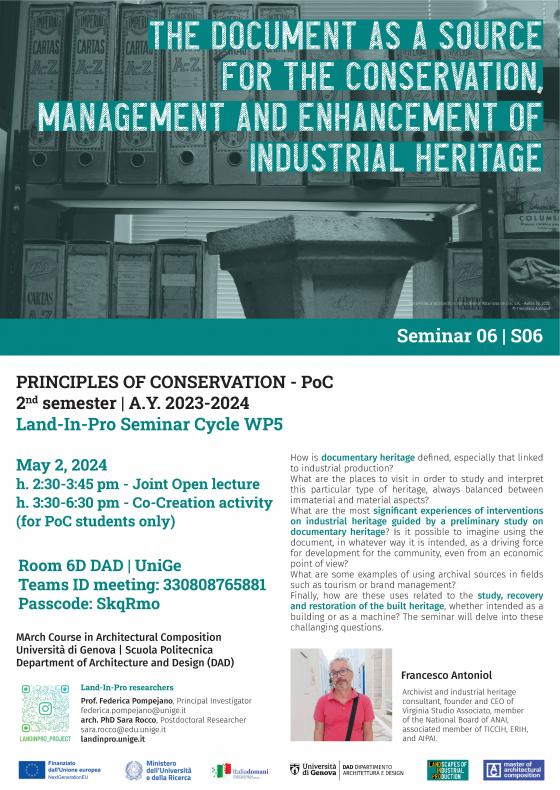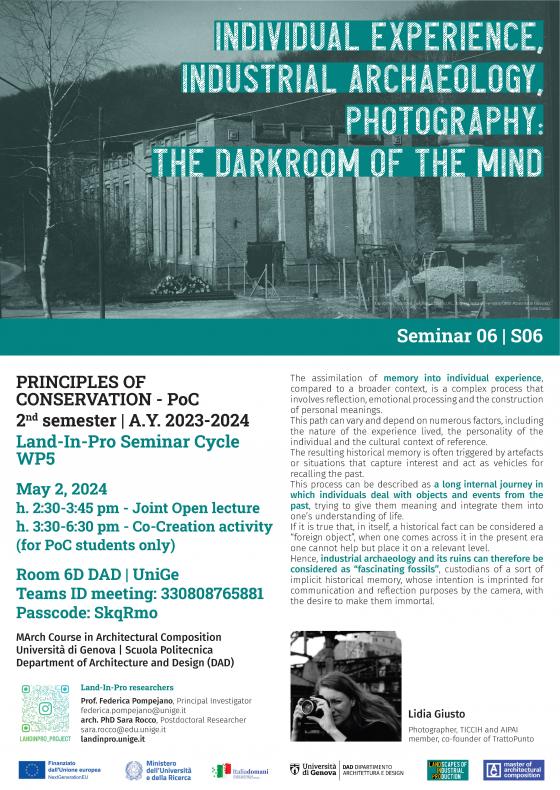

S06 | May 2, 2024
h. 2:30-3:45 pm - Joint Open Lectures [3:30-6:30 pm + Co-creation]
The Document as a Source for the Conservation, Management, and Enhancement of Industrial Heritage
Francesco Antoniol | Archivist and Industrial Heritage Consultant, founder and CEO of Virginia Studio Associato, member of the National Board of ANAI, and associated member of TICCIH, ERIH, and AIPAI.
Individual Experience, Industrial Archaeology, Photography: The Darkroom of the Mind
Lidia Giusto | Photographer, member of TICCIH and AIPAI, co-founder of TrattoPunto.
Link to the open lecture on Microsoft Teams.

Group 1 | G01
Gordon Matta-Clark: Anarchitecture
Gordon Matta-Clark, has been a central figure in the 1970s art scene, redefined urban space with his concept of "anarchitecture." Through daring architectural interventions, he transformed neglected structures into art pieces. Matta-Clark's anarchitecture blurred the lines between art and architecture, challenging societal norms and perceptions. His innovative approach, often involving cutting or removing sections of buildings, created new perspectives on urban landscapes. Photography is a mean through which the essence of Matta-Clark's ephemeral installations is captured. His photographs not only preserved his work but also became integral to understanding the temporal nature of anarchitecture, immortalizing its rebellious spirit.
Keywords: Gordon Matta-Clark, Anarchitecture, Photography
Students: Laura Di Domenico, Margherita Squeo, Mohammad Golshan, Oussama Yahiaoui, Seyedehmaedeh Mousavi, Johan August Skjomming

Group 2 | G02
A family-owned business with a vision
From humble roots to haute couture, Zegna revolutionized menswear. Since 1910, the Italian fashion house has crafted elegance from wool, weaving tradition with innovation. But beyond threads, their legacy threads through sustainability. Enter Oasi Zegna, a sanctuary born in 1993 from a vision of harmony. Nestled in the Alps, it’s not just a refuge but a commitment to nature, caring biodiversity and culture. With each stitch, Zegna stitches together heritage and responsibility, redefining luxury. Their story is one of fabric and forest, style and stewardship, where the past inspires the future, weaving a narrative of timeless elegance and environmental reverence.
Keywords: Oasi Zegna, Archive, History
Students: Alberto Tonelli, Andrea Rebora, Emiljano Nokaj, Arina Zhalnina, Masoud Ebrahimpour Taher

Group 3 | G03
A journey to the past – Dudelange Case
Photography serves as a potent bridge between the past and the future, especially when it comes to documenting industrial heritage. Dudelange, nestled in Luxembourg, is renowned for its industrial past and has long been associated with the iron and steel industry, shaping its identity and leaving an indelible mark to this day. Photography emerges as a pivotal tool in carrying this legacy forward, transforming remnants of the past into timeless visual narratives. Through the lens of a camera, photographers document these structures, encapsulating the essence of a bygone era. Yet, the mnemonic power of photography transcends mere documentation; it ignites aspirations for the future. Photographs capturing Dudelange's industrial heritage underscore the importance of progress by showcasing the evolution of industrialization and deindustrialization processes.
Keywords: Industrial Legacy, Lens, Change
Students: Lee Chai Yoong, Li Xinshu, Magdalena Andrea Ghiata, Marina Galvao Jaqueira Fantine, Sogand Amiri, Ruveyeda Asude Kilic

Group 4 | G04
Edward Burtynsky: Oil
Edward Burtynsky is a photographer who predominately works on the theme of the mutation of landscapes through industry. His images seek to illustrate the dilemma of our modern existence.
The series “Oil” depicts different angles regarding the extraction, needs and consequences of oil and is telling a critical narrative. The beauty that can represent these industrial infrastructures can be in unison with the surrounding nature but also distracting and interfering. The landscape is taken over by a dehumanized essence. Simultaneously Burtynsky also stresses the “why”. Our modern society is dominated by ways of mobility and consumerism which depend on oil. The dichotomy between the utopic idea represented by the oil industry and the raw reality is shown by the illustrations of modern remains and abandoned landscapes.
Keywords: Oil, Photography, Industrial Landscape
Students: Maximilian Blender, Leonard Gmeiner, Nicolas Vincent, Toropova Aleksandra, Kseniia Alferova

Group 5 | G05
The delicious history of Barilla
Keywords: Industries Archives, Barilla, History
Students: Hussin Noheir Mohamed Rehan, Belkbir Madjda, Allali Oussama, Dasdemir Zeynep, Asyl Awawdeh

Group 6 | G06
The Square Colosseum as a Fendi box
During the history of the Maison Fendi, born from an all-female entrepreneurship, whose work was then continued by the famous style icon Karl Lagerfeld, what created a lot of controversy was the choice of the Palazzo della Civiltà Italiana as its headquarters. In choosing this building, which was born as the site of the Universal Exhibition of 1942 under Fascism, Fendi seems to have wanted to ignore its history and see the structure as a simple archive box. In any case, the Square Colosseum is part of the Cultural Heritage of the Italian Ministry and is bound for artistic purposes, so perhaps Fendi's choice to give the building a new image is not to be judged too badly.
Keywords: Controversy, New value, Container
Students: Giulia Caprile, Christian Galleano, Julia Mairla Freitas Baia, Ekaterine Macharashvili

Group 7 | G07
The lens behind Dire Dawa old railway station
Photography serves as a powerful conduit for documenting the historical significance of Dire Dawa's old train station in Ethiopia. Through the lens, intricate details, historical nuances, and the ambience of the station are immortalized, enabling the observer to traverse through time and connect with its heritage. Each snapshot captures the physical aspects telling diverse stories and memories embedded in them. By sharing these images, we stress how photography becomes an invaluable tool in documenting the legacy of Dire Dawa's old train station.
Keywords: Infrastructure, Photographic gaze, Industrial heritage
Students: Hassanein Asser Ibrahim Khalil Ibrahim, Zewdie Bruk Ngusie, Reyhani Aida, Rohani Sheida Ismayilov Ismayl

This project has received funding from the National Recovery and Resilience Plan (NRRP) - Mission 4 “Education and Research” - Component 2 “From Research to Business” - Investment 1.2 “Funding projects presented by young researchers” and the European Union's Next Generation EU Recovery Plan - Project no. 100027-2022-FP-PNRR-YR_MSCA_0000005"

Disclaimer
The responsibility for the content published on the Land-In-Pro Seminar Cycle + Co-creation activities lies with the authors and reflects only their views. The Italian Ministry of University and Research and the European Commission are not responsible for any use that may be made of the information contained therein.

































































